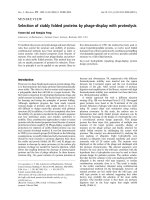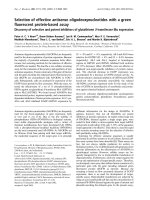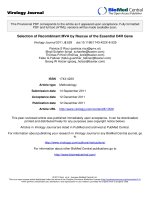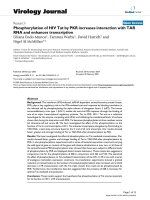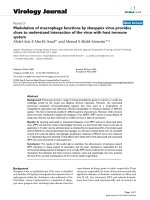Báo cáo sinh học: "Selection of allozyme genotypes of two species of marine gastropods (genus Littorina) in experiments of environmental stress by nonionic detergent and crude oil-surfactant mixtures" pptx
Bạn đang xem bản rút gọn của tài liệu. Xem và tải ngay bản đầy đủ của tài liệu tại đây (494.09 KB, 8 trang )
Original
article
Selection
of
allozyme
genotypes
of
two
species
of
marine
gastropods
(genus
Littorina)
in
experiments
of
environmental
stress
by
nonionic
detergent
and
crude
oil-surfactant
mixtures
E. Nevo
B. Lavie
University
of Haifa,
Institute
of
Evolution,
Mt
Carrnel,
Haifa,
Israel
(received
25
January
1989,
accepted
5
May
1989)
Summary -
Two
marine
gastropods,
Littorina
punctata
and
L.
neritoides
were
exposed
in
laboratory
experiments
to
the
controlled
environmental
stress
of
pollution
by
detergent
and
by
crude
oil-detergent
mixtures
in
aqueous
solutions.
The
allozyme
frequencies
of
phosphoglucose
isomerase
(PGI)
were
tested
in
both
species
and
amino-peptidase
(AP)
only
in
L.
neritoides.
Our
results
indicate
differential
survivorship
of
allozyme
genotypes
for
both
species,
both
types
of
pollution
and
both
enzymes
observed.
These
results
indicate
the
sensitivity
of
allozymes
to
environmental
stress,
reflect
the
adaptive
nature
of
some
allozymes,
and
support
the
idea that
allozymes
could
be
used
as
detectors
of
organic
pollutants
in
the
sea.
selection -
organic
pollution -
allozyme
polymorphism -
marine
gastropod
Résumé -
Sélection
de
génotypes
allozymes
chez
deux
espèces
de
gastéropodes
marins
(genre
Littorina)
dans
des
expériences
de
stress
environnemental
par
un
détergent
non
ionique
et
par
ses
mélanges
avec
des
huiles
brutes.
Deux
gastéropodes
marins,
Littorina
punctata
et
L.
neritoides,
ont
été
exposés
en
laboratoire
des
stress
environnementaux
correspondant
à
une
pollution
par
un
détergent
et
par
ses
mélanges
avec
des
huiles
brutes
en
solutions
acqueuses.
Les
fréquences
des
allozymes
de
la
phosphoglucose-isomérase
(PGI)
ont
été
testées
chez
les
deux
espèces,
et
celles
de
l’amino-peptidase
(AP)
chez
L.
neritoides
seulement.
Les
résultats
indiquent
une
survivance
différentielle
des
différents
génotypes,
pour
les
deux
espèces,
pour
les
deux
types
de
pollution,
et
pour
les
deux
enzymes
étudiées.
Ces
résultats
indiquent
que
les
adloxymes
sont
sensibles
à
des
stress
de
l’environnement,
ils
reflètent
la
nature
adaptative
de
certains
aldozymes,
et
renforcent
l’idée
que
des
allozymes
puissent
être
utilisés
pour
détecter
des
polluants
organiques
dans
la
mer.
sélection -
pollution
organique -
polymorphisme
enzymatique -
gastéropode
marin
INTRODUCTION
The
evolutionary
significance
and
dynamics
of
the
vast
amount
of
protein
polymorphisms
in
nature,
and
the
relative
importance
of
the
deterministic
and
stochastic
forces
operating
to
maintain
them,
awaits
additional
critical
testing.
If
this
variation
is
largely
adaptive,
then
it
is
exploitable
in
breeding
(Nevo
et
al.,
1982,
Nevo
1986),
meaningful
in
conservation
(Frankel
&
Soule,
1981;
Schonewald-Cox
et
al.,
1983;
Soule,
1987),
and
exploitable
as
a
detector
and
monitor
of
environmental
quality
(Nevo
1986,
Nevo
et
al.,
1983).
In
the
present
study,
we
tested,
in
controlled
laboratory
experiments,
the
influence
of
a
nonionic
detergent
and
of
crude
oil-detergent
mixtures
in
aqueous
solutions
on
allozymic
variation
in
the
related
species
of
marine
gastropods
Littorina
punctata
and
L.
neritoides.
Their
genetic
structure,
based
on
17
loci
in
three
Mediterranean
sites
along
the
Israel
coast
was
described
by
Noy
et
al.
(1987).
Of
the
17
loci
tested,
only
phosphoglucose
isomerase
(PGI )
for
both
species
and
amino
peptidase
(AP )
for
L.
neritoides
were
found
suitable
for
pollution
investigations,
which
depend
on
the
following
stringent
criteria:
-
Loci
tested
for
pollution
must
be
strongly
polymorphic
(>10%)
in
order
to
detect
differential
mortality
in
sample
sizes
involving
several
hundreds
of
animals.
-
The
enzyme
tested
must
also
remain
active
in
the
dead
animals
so
that
the
distribution
of
genotypes
can
be
compared
directly
between
dead
and
live
animals.
Thus,
no
sampling
error
is
added that
would
bias
the
results.
-
A
high
resolution
is
imperative
when
scoring
the
electrophoretic
results,
because
the
difference
in
allozymic
frequencies
between
live
and
dead
animals
may
be
small.
Our
results
indicate
differential
tolerance
of
allozymes
to
both
pollutants
tested,
as
was
found
in
our
previous
studies
(reviewed
in
Nevo,
1986),
implying
that
at
least
some
of
the
genetic
diversity
found
in
natural
populations
may
be
exploitable
in
the
service
of
man
as
a
genetic
monitor
of
marine
pollution.
MATERIAL
AND
METHODS
Species
tested
and
experimental
design
The
present
study
involves
two
related
marine
mollusc
species:
Littorina
punctata
(Gemelin)
and
L.
neritoides
(L.)
whose
ecology
in
Israel
was
studied
by
Palant
&
Fishelson
(1968).
Several
hundreds
of
individuals
from
each
species
were
collected
from
the
rocky
shores
of
the
Haifa
region
and
introduced
in
batches
of
50-100
individuals
into
partially
filled
80
L
aquaria
(70
x
30
x
40
cm)
at
the
Institute
of
Evolution,
University
of
Haifa,
Israel.
Fresh
sea
water
was
pumped
from
a
30m
depth
at
the
Shikmona
National
Institute
of
Oceanography
and
transported
to
the
laboratory.
The
two
Littorina
species
tend
to
crawl
on
the
aquaria
walls,
above
the
water
level.
To
avoid
this,
they
were
placed
in
quadrangular
cages
(25
x
25
x
5
cm)
made
of
perspex.
These
cages
were
subdivided
into
smaller
interconnected
cells
(5 x 5 x
5 cm)
by
a
plastic
net
so
that
water
currents
could
pass
freely
through
all
cells.
Each
cell
held
two
animals.
Conditions
in
all
aquaria
were
identical
(22
°C,
pH
= 8.1;
constant
aeration
and
no
food
was
provided
throughout
testing).
All
tests
were
conducted
simultaneously
and
were
matched
with
a
control.
Survival
in
the
controls
was
always
100%.
The
experimental
organisms
were
observed
daily;
dead
animals
were
removed
and
frozen
(-80
°C).
When
mortality
reached
50%
(LD
so),
the
test
was
terminated
and
all
survivors
were
frozen
(-80
°C).
The
duration
of
the
test
(2-10
days)
varied,
depending
upon
the
concentrations
of
pollutants
(Tables
I,
II).
Similar
trends
have
been
observed
in
all
concentrations,
therefore
the
results
were
pooled.
The
pollutants
The
nonionic
detergent
used
was
the
commercially
available
Marlophen
89
(Hulls,
West
Germany).
This
product
is
a
nonylphenol
ethoxylate
having
an
approx-
imate
molecular
weight
of
643,
the
molar
ratio
between
the
ethylene
oxide
and
the
nonylphenol
being
9.55:1
respectively.
This
nonionic
detergent
is
of
the
&dquo;hard&dquo;
type,
that
is,
resistant
to
biological
degradation.
The
crude
oil
used
(&dquo;Sonol
2&dquo;,
obtained
from
the
Israeli
Oil
Refineries
Ltd,
in
Haifa),
had
the
fol-
lowing
specifications:
density
at
15
°C:
0.9152.
Distillation
Range
(%
wt):
to
150°C,
8.3%;
150-250
°C,
17.7%;
250-400
°C,
21.2%;
Res.
>
400,
51.9%.
Kine-
matic
Viscosity:
at
122
f,
15.8
cP.
Total
Sulfur
(%
wt):
1.4.
Salt
PTB:
11.
Water
(%
V):
0.05.
Carbon
Residue
(%
wt):
5.3;
Asphaltenes
(%
wt):
0.8.
Electrophoretic
analysis
For
the
electrophoretic
analysis,
whole
frozen
animals
were
homogenized
and
studied
by
horizontal
starch
gel
electrophoresis
(Selander
et
al.,
1971).
For
the
preparation
of
the
buffers
used
for
the
assay,
see
Noy
et
al.
(1987).
The
alleles
were
recorded
according
to
their
place
on
the
electrophoretic
gel:
F
was
the
fastest
(most
anodal)
and
S-
was
the
slowest
allele.
The
PGIlocus
in
both
species
had
3
alleles
(S,
M,
F);
the
AP
locus
had
5
alleles
(S-,
SMM
+,
F).
As
the
electrophoretic
analysis
is
much
more
expensive
and
time
consuming
than
the
viability
survey,
only
part
of
the
participants
in
these
experiments
were
analyzed
electrophoretically
(Table
I,
II).
RESULTS
Table
I
summarizes
all
the
data
obtained
on
allozyme
frequencies
under
treatment
with
nonionic
detergent
and
crude
oil-detergent
mixtures
in
aqueous
solutions
at
the
PGI
locus,
for
Littorina
punctata.
When
the
pollutant
used
was
the
nonionic
detergent
by
itself,
selection
acted
against
the
genotype
FF
and
the
allele
F
in
general
and
favored
the
genotype
MM.
The
fact
that
the
statistical
results
also
show
a
higher
frequency
of
the
allele
M
among
the
live
animals
than
among
the
dead,
is
a
consequence
of
the
huge
proportion
of
the
genotype
MM
among
the
live
animals;
other
M
bearing
genotypes
were
not
favoured.
’
When
the
pollutant
used
was
crude
oil
and
non-ionic
detergent
mixture,
a
reversion
in
the
viability
fitness
could
be
observed:
In
general,
the
FF
genotype
and
F
allele
were
favoured
by
the
selection
which
acted
against
the
SS
genotype
and
the
S
allele.
Table
II
summarizes
all
the
data
obtained
on
allozyme
frequencies
under
treat-
ment
with
nonionic
detergent
and
crude
oil-detergent
mixtures
in
aqueous
solutions
at
the
PGI
and
AP
loci
for
Littorina
neritoides.
The
trends
were
similar
in
both
types
of
pollution,
but
more
accentuated
in
the
combined
pollution.
Heterozygotes,
in
general,
showed
higher
fitness
viability
(especially
F1VI
in
the
PGI system
in
oil
pollution.
In
the
AP
system,
the
FIBr
+
in
detergent
pollution
and
M+S
in
oil
pollu-
tion).
Considering
homozygotic
genotypes,
the
detergent
applied
by
itself
favoured
the
FF
genotype
of
PGI,
and
the
combined
pollution
acted
against
the
MM
geno-
type
of
PGI and
against
the
MM
and
SS
genotypes
of
AP.
Notably,
while
the
trend
of
higher
frequency
of
heterozygotes
among
the
sur-
vivors
of
oil
pollution
was
not
significant
for
Littorina
punctata
alone,
the
combined
probabilities
for
both
species
was
P
<
0.001; x!
=
25.4346
(Sokal
&
Rohlf,
1969).
DISCUSSION
The
effects
of
detergents
on
the
marine
biota
were
reported
by
several
studies:
Man-
well
&
Baker
(1967)
performed
starch
gel
electrophoresis
on
a
variety
of
enzymes
and
other
proteins
that
had
been
exposed
to
detergent
pollution.
They
worked
on
in
vitro
tissues,
so
they
were
unable
to
observe
the
differential
survivorship
of
vari-
ous
genotypes.
They
discussed
only
the
general
influence
of
detergent
on
solubility,
activity
and
electrophoretic
mobility
of
proteins.
The
in
vivo
effects
of
detergents
on
the
marine
biota
were
reported
in
several
studies;
on
the
chemical
senses
of
fish
(Bardach
et
al.,
1965)
on
marine
gastropods
(Bryan,
1969)
and
on
crustacea
(Kaim-Malka,
1972).
But
these
studies
did
not
deal
with
the
influence
of
detergent
pollution
on
the
genetic
patterns
of
allozyme
polymorphisms.
Oil
pollution
of
the
sea
has
received
a
great
deal
of
attention
from
research
workers
throughout
the
world,
especially
due
to
disasters
of
giant
oil
tankers
in
the
oceans.
Certain
constituents
of
oil,
particularly
the
aromatic
hydrocarbons,
can
shown
in
laboratory
experiments
to
be
harmful
to
marine
organisms.
Effects
of
oil
pollution
on
coral
reef
communities
has
been
critically
reviewed
by
Loya
&
Rinkevitch
(1980).
They
reported
a
syndrome
of
oil
effects,
including
complete
lack
of
colonization
by
hermatypic
corals
in
reef
areas
chronically
polluted
by
oil,
decrease
in
colony
viability,
damage
to
the
reproductive
systems
of
corals,
lower
life
expectancy
of
planulae,
and abnormal
behavioral
responses
of
planulae
and
corals.
For
the
herring
gull
chick
(Larus
argentatus),
Miller
et
al.
(1978)
reported
that
a
single
small
oral
dose
of
Kuwait
or
South
Louisiana
crude
oil,
caused
cessation
of
growth,
osmoregulatory
impairment,
and
hypertrophy
of
hepatic
adrenal
and
nasal
gland
tissue.
The
biological
effects
of
oil
pollution
on
littoral
communities
were
described
by
Beer
(1968),
and
the
acute
toxicities
of
crude
oils
and
oil
dispersant
mixtures
on
marine
fish
and
inverterbrates
were
reported
by
Eisler
(1975).
A
post
hoc
approach
to
the
problem
of
selection
pressure
on
specific
genotypes
of
marine
organisms
by
oil
pollution
was
reported
by
Battaglia
et
al.
(1980),
who
compared
the
genotypic
pattern
of
Tisbe
holothuriae
and
Mytilus
galloprovincialis
at
sites
with
various
degrees
of
oil
pollution.
They
found
significant
differences
in
viability,
especially
for
genotypes
of
the
locus
PGI
In
an
early
study
with
detergent
and
with
crude
oil-detergent
pollution,
we
have
found
in
laboratory
controlled
experiments,
differential
viability
of
PGI
genotypes
of
the
marine
gastropods
Monodonta
turbinata
and
M.
turbiformis
(Lavie
et
al.,
1984)
and
of
six
loci
tested
in
the
marine
gastropod
Cerithivrn
scabridvrra,
either
singly
or
in
a
two-locus
genetic
structure
(Nevo
&
Lavie,
1989).
The
present
study
reports
the
selective
nature
of
the
genotypes
in
an
a
priori
designed
experiment,
with
precise
concentrations
of
specific
pollutants,
avoiding
any
effects
of
additional
unknown
pollutants.
The
pollutant
concentration
needed
in
order
to
obtain
LD50
was,
in
all
cases,
much
higher
than
its
concentration,
even
in
the
polluted
sea
environment.
Yet,
while
pollution
effects
may
be
small
in
open
sea
situations,
effects
are
certainly
appreciable
locally
in
estuaries
and
coastal
waters.
The
laboratory
experiments
considered
only
survivorship
because
they
involved
species
that
do
not
reproduce
successfully
in
laboratory
conditions.
Yet,
in
nature,
tolerant
genotypes
may
not
only
live
longer,
but
presumably
also
reproduce
successfully
in
the
polluted
environment.
Like
Battaglia
et
al.
(1980),
we
found
that
oil
pollution
favoured
the
heterozy-
gotes.
As
in
our
previous
studies
on
detergent
and
oil
pollution
(Lavie
et
al.,
1984;
Nevo
et
al.,
1988),
we
found
for
L.
neritoides,
similar
trends
in
detergent
pollu-
tion
by
itself
and
in
the
pollution
by
oil-surfactant
mixtures.
This
may
have
been
influenced
by
the
fact
that
the
surfactant
used
in
the
oil-surfactant
mixtures,
was
the
detergent
in
case.
Yet
for
L.
punctata,
the
synergism
of
the
two
pollutants
pro-
duced
results
completely
opposed
to
the
pollution
by
detergent
alone.
This
is
in
good
accord
with
our
previous
experiments
on
the
synergetic
effects
of
pollutants
(cadmium
and
mercury
pollution).
We
found
that
the
combined
pollution
had
a
unique
influence
on
the
distribution
of allozyme
frequences
for
Cerithium
scabridum
(Lavie
&
Nevo,
1988);
for
L.
punctata
and
L.
neritoides
(Lavie
&
Nevo,
1987),
and
for
Palaemon
elegans
(Ben-Shlomo
&
Nevo,
1988).
The
biochemical
mechanisms
involved
in
differential
viability,
and
the
specific
targets
of
selection
need
future
elucidation.
We
conclude
that
the
present
study
supports
previous
ones
(reviewed
in
Nevo,
1986),
suggesting
that
at
least
some
allozyme
polymorphisms
are
subject
to
natural
selection.
Actually,
during
our
research
program
in
controlled
environments
(10
types
of
pollutants
and
six
species
of
marine
organisms),
only
a
single
case
of
no
differential
survivorship
due
to
pollution
could
be
detected
(e.g.
in
Monodonta
turbifor!ais
in
zinc
pollution)
[Nevo
et
al.,
1983!.
The
sensitivity
of
change
in
allele
frequencies
of
allozymes
to
environmental
stress
makes
them
appropriate
as
genetic
detectors
and
monitors
of
organic
pollutants.
Such
direct
genetic
indicators
can
complement
other
methods
of
bio-
and
chemical
monitoring.
The
merit
of
genetic
monitoring
is
that
it
alerts
us
to
both
the
short-and
long-term
genetic
changes
that
populations
undergo,
before
their
extermination
resulting
from
environmental
stress
pollution.
ACKNOWLEDGEMENTS
We
thank
Shimon
Simson
for
field
and
laboratory
assistance,
and
wish
to
extend
our
deep
gratitude
for
financial
support,
to
FAO/UNEP,
to
the
Israel
Discount
Bank
Chair
of
Evolutionary
Biology
and
to
the
Ancell-Teicher
Research
Foundation
for
Genetics
and
Molecular
Evolution,
established
by
Florence
and
Theodore
Baumritter
of
New
York.
REFERENCES
Bailey
N.T.J.
(1959)
Statistical
Methods
in
Biology.
English
University
Press,
London,
pp.
38-39
Bardach
J.E.,
Fujiya
M.
&
Holt
A.
(1965)
Detergents:
Effects
on
the
chemical
senses
of
the
fish
Tetalrus
natilis
(le
Suer).
Science
148,
1605-1607
Battaglia
B.,
Bisol
P.M.
&
Rodino
E.
(1980)
Experimental
studies
on
some
genetic
effects
of
marine
pollution.
Helgol.
Wiss.
Meeresunters.
33,
587-595
Beer
J.V.
(1968)
In:
The
Biological
Effects
of
Oil
Pollution
on
Littoral
Communities
(J.C.
Carthy
&
D.R.
Arthur
eds),
Field
Studies
Council
London,
123
Ben-Shlomo
R.
&
Nevo
E.
(1988)
Isozyme
polymorphism
as
monitoring
of
marine
environments:
The
interactive
effect
of
cadmium
and
mercury
pollution
on
the
shrimp
Palaemon
elegans.
Mar.
Pollut.
Bull.
19,
314-317
Bryan
G.W.
(1969)
The
effects
of
oil
spill
removers
(detergents)
on
the
gastropod
Nucella
lapellus
on
a
rocky
shore
and
in
the
laboratory.
J.
Mar. Biol Assoc.
U.K.
49,
1067-1092
Eisler
R.
(1975)
Acute
toxicities
of
crude
oils
and
oil-dispersant
mixtures
to
Red
Sea
fishes
and
inverterbrates.
Isr.
J.
Zool.
24,
16-27
Frankel
O.H.
&
Soule
M.
(1981)
Conservation
and
Evolution,
Cambridge
Univ.
Press,
London/New
York
Kaim-Malka,
R.A.
(1972)
Action
des
detergents
sur
deux
esp6ces
de
Crustac6s
(Action
of
detergents
on
two
species
of
crustacea).
Rapp.
P.
V.
R6un.
Cons.
Int.
Ex
P
lor.
Mer.
21,
255-258
Lavie
B.
&
Nevo
E.
(1987)
Differential
fitness
of
allelic
isozymes
in
the
marine
gas-
tropods.
Littorina
punctata
and
Littorina
neritoides
exposed
to
the
environmental
stress
of
the
combined
effects
of
cadmium
and
mercury
pollution.
Environ.
Man
11,
345-349
Lavie
B.
&
Nevo
E.
(1988)
Multilocus
genetic
resistance
and
susceptibility
to
mercury
and
cadmium
pollution
in
the
marine
gastropod
Cerithium
scabridum.
Aquat.
Toxicol
13,
291-296
Lavie
B.,
Nevo
E.
&
Zoller
U.
(1984)
Differential
viability
of
phosphoglucose
isomerase
allozyme
genotypes
of
marine
snails
in
nonionic
detergent
and
crude
oil-surfactant
mixtures.
Environ.
Res.
35,
270-276
Loya
Y.
&
Rinkevich
B.
(1980)
Effects
of
oil
pollution
on
coral
reef
communities.
Mar.
Ecol.
Prog.
Ser.
3,
167-180
Manwell
C.
&
Baker
C.M.A.
(1967)
A
study
of
detergent
pollution
by
molecular
methods:
Starch
gel
electrophoresis
of
a
variety
of
enzymes
and
other
proteins.
J.
Mar.
Biol.
Assoc.
U.K.
47,
659-675
Miller
D.S.,
Peakall
D.B.
&
Kinter
W.B.
(1978)
Ingestion
of
crude
oil:
Sublethal
effects
in
herring
gull
chicks. Science
199,
315-317
Nevo
E.
(1986)
Pollution
and
genetic
evolution
in
marine
organisms:
Theory
and
practice.
In:
Environmental
Quality
and
Ecosystem
Stability
(Z.
Dubinsky
&
Y.
Steinberger
eds)
Bar
Ilan
Univ.
Press,
Ramat-Gan,
Israel,
Vol
3
A/B,
pp.
841-848
Nevo
E.
&
Lavie
B.
(1989)
Differential
viability
fitness
of
allelic
isozymes
in
the
marine
gastropod
Cerithium
scabridnm
exposed
to
the
environmental
stress
of
nonionic
detergent
and
crude
oil-surfactant
mixtures.
Genetica
(in
press)
Nevo
E.,
Golenberg
E.,
Brown
A.H.D.,
Beiles
A.
&
Zohary
D.
(1982)
Genetic
diversity
and
environmental
associations
of
wild
wheat
Triticum
dicoccoides,
in
Israel.
Theor.
Appl.
Genet.
62,
241-254
Nevo
E.,
Lavie
B.
&
Ben-Shlomo
R.
(1983)
Selection
of
allelic
isozyme
polymor-
phisms
in
marine
organisms:
Pattern,
theory
and
application.
In:
Isozymes:
Current
Topics
in
Biological
and
Medical
Research.
(Rattazi
M.C.,
Scandalios
J.G.
&
Whill
G.S.
eds)
Alan
R.
Liss,
Inc.,
New
York,
30,
pp.
69-92
Nevo
E.,
Lavie
B.
&
Ben-Shlomo
R.
(1988)
Population
genetic
structure
of
marine
organisms
as
detectors
and
monitors
of
marine
pollution,
FAO/UNEP.
Scient.
Reports
24,
37-49
Noy
R.,
Lavie
B.
&
Nevo
E.
(1987)
The
niche-width
variation
hypothesis
revisited:
Genetic
diversity
in
the
marine
gastropods
Littorina
punctata
(Gmelin)
and
L.
neritoides
(L).
J.
Exp.
Mar.
Biol.
Ecol.
109,
109-116
Palant
B.
&
Fishelson
L.
(1968)
Littorina
punctata
(Gmelin)
and
Littorina
neri-
toides
(L)
(Mollusca,
Gastropoda)
from
Israel:
Ecology
and
annual
cycle
of
genital
system.
Isr.
J.
Zool.
17,
145-160
Schonewald-Cox
C.M.,
Chambers
S.M.,
142acBryde
B.
&
Thomas
L.
(1983)
Genetics
and
Conservations.
The
Benjamin
Cummings
Pub.
Co.,
Inc.,
London
Selander
R.,
Smith
M.H.,
Young
S.Y.,
Johnson
E.W.
&
Gentry
G.B.
(1971)
Bioche-
mical
polymorphism
and
systematics
in
the
genus
Peromyscns.
I.
Variation
in
the
old
field
mouse
(Perorr!yscus
polionotus).
Univ.
Tex.
Publ.
7103,
49-90
Siegel
S.
(1956)
Nonparometric
Statistics
for
the
Behavioral
Sciences.
Academic
Press,
New
York
Sokal
R. R.
&
Rohlf
F.
J.
(1969)
Biometry.
Freeman,
San
Francisco
Soule
E.
(ed.)
(1987)
Viable
Populations
for
Conservation.
Cambridge
University
Press,
Cambridge,
New
York
